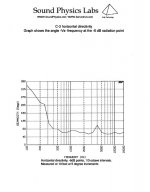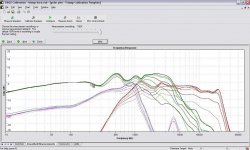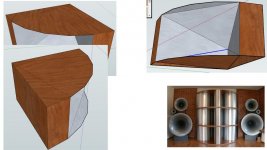Sheldon said:
If I were recommending something in that size range, I'd concur. I'm happy with what I have, but if I were starting now, that's what I'd get (or, in my case, make). I haven't heard the Summas, but I have - sort of. My system is based on Nick Mckinney's original DIY Unity's. I've followed Dr. Geddes work the last couple of years, and even bought some foam for my horns from him - probably the first Diy'er to do so. My speakers are actively crossed over with a DEQX and an analog active crossover to the sub portion, so they are active 4 way.
If I take polar measurements of the horn and mid bass, I get something that looks very much like those on the Gedlee site. In the Unity set up, the compression driver is crossed to the mids at about 1.2kHz and the horn to the mid bass at about 350 Hz. I've experimented with leaving out the Unity Mids and crossing the compression driver directly to the 15" mid bass at about 1.3 kHz (closest match of the polar responses) The difference between the Unity configuration and the pseudo Summa is fairly subtle. The full Unity system places the image level a little higher (which I like), but little else changes. The Unity system is very good, but unless you are going for very high SPL, I would say that the added complexity isn't cost effective. The Unity can be done passively too, and the crossover might be a little easier to perfect than for the Summa, but not by much.
The Unity can make do with a mid bass that doesn't reach up into the mid range, but the drivers I have excel there anyway. Cheaper and easier to select a better mid bass than to use the Unity Mids.
Sheldon,
Your post really got my attention! I live alone in a gi-nor-mous house, and I've semi-seriously considered purchasing a Unity to replace my JBLs. At the moment the Summas are in my living room, and my JBLs were relegated to one of my bedrooms upstairs.
So it's quite a surprise to hear that they would sound so similar. But looking at the dimensions of the Unity and the Summa, it starts to make sense. When I look at the pictures at Cowan's sight, the unities look hyoooge, but I guess they're actually the same width really:
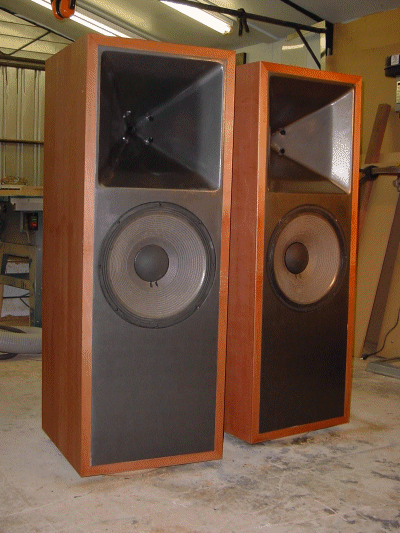
The Summas are approximately 20" wide, and taper at the back. The Lambda Unity appears to be about an inch narrower.
An externally hosted image should be here but it was not working when we last tested it.
It really brings up a lot of interesting questions!
The whole point of the unity is to drive the waveguide with the mids and the compression driver from the same point. The mids in the Unity cover a two octave range, from 300hz to 1200hz. This is basically the most important range in the entire loudspeaker, so it's critical to get this range "correct."
What's interesting is that the waveguide in the Unity can only provide pattern control to about 750hz, based on it's width. (speed of sound / 18in waveguide = 744hz)
Which begs the question - if the waveguide in the Unity can only control directivity down to 750hz, why bother at all? There are many competent compression drivers which can be run down to that range.
The Danley synergy horn includes many subtle improvements - but perhaps the biggest improvement is that it's simply BIGGER! With a width that's almost twice as big as the Unity horn, the SH50 synergy horn has directivity control down to 478hz.

I'd be interested to know how the SH100 and Summa designs compare, since both are a bit more practical than a DIY unity clone.
Patrick Bateman said:
What's interesting is that the waveguide in the Unity can only provide pattern control to about 750hz, based on it's width. (speed of sound / 18in waveguide = 744hz)
Which begs the question - if the waveguide in the Unity can only control directivity down to 750hz, why bother at all?
First, I doubt that horn is not narrowing considerably at 750 Hz. I usually use a half wavelength instead of a whole wavelength in my approximation of narrowing. That would make it a 1500 Hz horn, which, if it is the same size as the Summa would be correct. The Summa narrows slightly at 1500 Hz and so will that unity - if the wavefront in the mouth is coherent. If its not then in all likelyhood its polars at that point will not be very good anyways.
To your second point, that is exactly the way that I see it too. I just don't get the interest in using four midranges, except for the larger power handling capacity. While they may couple to the horn "well" they can't be ideal, and could never be as good as a compression driver at the throat with no discontinuities at all.
I am not in a position to comment on the Summas versus the Unity in large venues where power is a limiting factor, but in a home, I just cannot see the need to resort to seperate drivers in the waveguide.
Do the Summas not play loud enough? Do you need more SPL?
jason_watkins said:I'd be interested to know how the SH100 and Summa designs compare, since both are a bit more practical than a DIY unity clone.
I can't comment on an SH100, but I can tell you anything that you want to know about the Summas.
I believe the advantage gained from using the midranges in the horn is that they're concentrically mounted with the HF device. Maybe this is not a big deal for home usage with one speaker per position, but the unities were originally a prosound speaker design where array-ability is a concern. So with the midranges (and possibly LF devices) mounted inside the horn, you can place the mouths of all the horns closer together.
IF you need the higher power of four midranges, THEN this makes sense, but I said that already. The concept is clear, but the need is not.
gedlee said:
First, I doubt that horn is not narrowing considerably at 750 Hz. I
usually use a half wavelength instead of a whole wavelength in my
approximation of narrowing. That would make it a 1500 Hz horn, which,
if it is the same size as the Summa would be correct. The Summa
narrows slightly at 1500 Hz and so will that unity - if the wavefront
in the mouth is coherent. If its not then in all likelyhood its
polars at that point will not be very good anyways.
To your second point, that is exactly the way that I see it too. I
just don't get the interest in using four midranges, except for the
larger power handling capacity. While they may couple to the horn
"well" they can't be ideal, and could never be as good as a
compression driver at the throat with no discontinuities at all.
I am not in a position to comment on the Summas versus the Unity in
large venues where power is a limiting factor, but in a home, I just
cannot see the need to resort to seperate drivers in the waveguide.
Do the Summas not play loud enough? Do you need more SPL?
I'm very happy with my Summas, no worries 😀
The Unity is a frighteningly complex design; there's one thing it does that's quite eye-opening. And keep in mind that were I to purchase a pair of SH-50s, I could easily resell them if they didn't live up to my expectations. At less than $5000 a pair, the seller is offering them for a price at which I could re-coup most of my investment.
When you first listen to the Summas, they basically sound like a
refined mini-monitor, but with gobs and gobs of headroom. They do not sound like a horn.
When you first listen to a Unity, there's something that catches your
attention immediately - they're incredibly articulate. Particularly
with spoken tracks, there's an ability to bring things "out of the
mix" that I've never heard from any other design. The only other
speaker I've personally heard which can do this is the cheap little
Gallo A'Diva speakers. But the Unity is almost distortion free, while the Gallos are audibly strained at very low listening levels.
The only explanation that I have for this is the consistent phase response of the Unity and Synergy horns. The phase response of the SH50 follows a gentle slope, whereas a traditional two-way has a phase response which shifts dramatically.
I couldn't find a phase plot of the Summa anywhere; as it is a traditional two-way I expect it would have a phase response which is similar to a typical two way, like this. In the plot below, we see that the phase jumps around quite a bit. It's interesting to note that the biggest phase shift happens in the midrange, where it's most audible. If I'm doing my math correctly, the phase shift would be virtually equivalent to the speaker being moved 4.5 inches as the phase shifts sixty degrees from 2khz to 500hz. Then it shifts *again*, in the next octave.
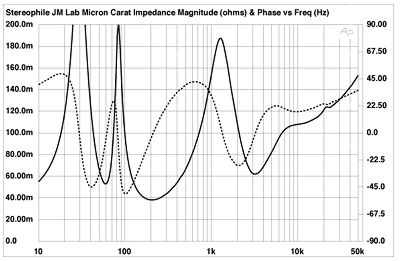
Now compare the phase plot above to the phase plot from a coaxial. This is an Audio Physics Kronos:
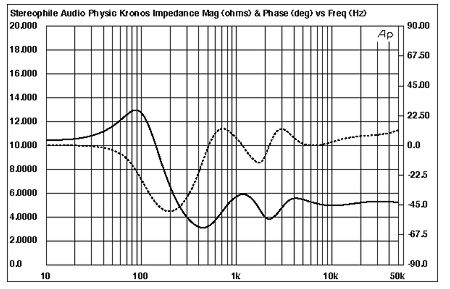
I would kill for a phase plot of the Gallo A'Divas, as that would let me make an educated guess about the phase response of a full-range system versus a Unity / Synergy horn.
Long story short - I'm guessing that a lot of the "Unity Magic" is due to it's phase response.
It's a bit amusing that the guys at Stereophile had the same reactions to an Audio Physics coaxial that I had to the Unity. Here's what they had to say about listening to a Johnny Cash song:
"Strap on your seatbelt
Ever since Audio Physic was founded, their slogan has been "No loss of fine detail." The Kronos shouted that slogan in caps. It had an effervescent quality that has been matched in my home listening experience by only the $41,500/pair Rockport Antares I wrote about in August 2002, and maybe by the $23,500/pair Aerial Acoustics 20T (which I reviewed in the April 2004 Stereophile). Notes appeared with startling clarity and transparency, then vanished without a trace. When I played Johnny Cash's American IV: The Man Comes Around (2 LPs, Lost Highway/American 440 063 336-1), each string of a strummed guitar, for instance, produced a hyper-pronounced physical sensation, as if I was surfing the strings on the guitar pick. There were times I felt more like Johnny Cash's dentist, so startlingly clear was every twitch of his mouth, teeth, and vocal cords. "
Here's what I posted about listening to Johnny Cash on my Unity clone:
"The unities excel at making sounds in the mix intelligible. I believe this is due to the proximity between the mids and the compression driver. Over the Summas, you can certainly hear the details of Johnny's delivery. For instance, you can practically hear him swallow between verses. But on the Unity it's more apparent."
"The most impressive thing I ever heard from my Unities was a Johnny Cash song. It was incredible how you could almost imagine Cash mouthing the words. The articulation of the Unity is just mind boggling. You're able to hear people speaking in the background on songs, and weird little glitches on the recordings also."
Here are the URLs if you want to read further:
http://www.diyaudio.com/forums/showthread.php?postid=1666348#post1666348
http://www.stereophile.com/floorloudspeakers/604audio/index1.html
"Strap on your seatbelt
Ever since Audio Physic was founded, their slogan has been "No loss of fine detail." The Kronos shouted that slogan in caps. It had an effervescent quality that has been matched in my home listening experience by only the $41,500/pair Rockport Antares I wrote about in August 2002, and maybe by the $23,500/pair Aerial Acoustics 20T (which I reviewed in the April 2004 Stereophile). Notes appeared with startling clarity and transparency, then vanished without a trace. When I played Johnny Cash's American IV: The Man Comes Around (2 LPs, Lost Highway/American 440 063 336-1), each string of a strummed guitar, for instance, produced a hyper-pronounced physical sensation, as if I was surfing the strings on the guitar pick. There were times I felt more like Johnny Cash's dentist, so startlingly clear was every twitch of his mouth, teeth, and vocal cords. "
Here's what I posted about listening to Johnny Cash on my Unity clone:
"The unities excel at making sounds in the mix intelligible. I believe this is due to the proximity between the mids and the compression driver. Over the Summas, you can certainly hear the details of Johnny's delivery. For instance, you can practically hear him swallow between verses. But on the Unity it's more apparent."
"The most impressive thing I ever heard from my Unities was a Johnny Cash song. It was incredible how you could almost imagine Cash mouthing the words. The articulation of the Unity is just mind boggling. You're able to hear people speaking in the background on songs, and weird little glitches on the recordings also."
Here are the URLs if you want to read further:
http://www.diyaudio.com/forums/showthread.php?postid=1666348#post1666348
http://www.stereophile.com/floorloudspeakers/604audio/index1.html
For home apps I tend to agree that a well done two way suffices for most folks, me included until I demo'd DSL's three way last Feb.. Short of finding a design that audibly eclipses these, if I ever bother to make another reference system it will be some form of three way Unity concept.
Anyway, FWIW, here's an F6 polar map of the SD/SPL's C^3, an early pro version of the Unity:
GM
Anyway, FWIW, here's an F6 polar map of the SD/SPL's C^3, an early pro version of the Unity:
GM
Attachments
I just realized I'm comparing apples to oranges; if I'm not mistaken Stereophile is publishing electrical phase, and Danley is publishing acoustic phase.
Dammit.
According to this thread, Danley swears by TEF measurements, and God only knows how much it costs to get one of THOSE:
http://www.diyaudio.com/forums/showthread.php?threadid=109574
Winslow might be interested to know that Richard Clark was telling everyone that his Grand National's success was thanks to lots and lots of TEF measurements 😀
When I was a teenager I saw an interview with him, and remember wondering what the heck a TEF machine was!
Couldn't find the article, but here's Clark talking about TEF for Monstercable:
http://www.monstercable.com/mpc/stable/tech/A2507_The_Energy_Time_Curve.pdf
Dammit.
According to this thread, Danley swears by TEF measurements, and God only knows how much it costs to get one of THOSE:
http://www.diyaudio.com/forums/showthread.php?threadid=109574
Winslow might be interested to know that Richard Clark was telling everyone that his Grand National's success was thanks to lots and lots of TEF measurements 😀
When I was a teenager I saw an interview with him, and remember wondering what the heck a TEF machine was!
Couldn't find the article, but here's Clark talking about TEF for Monstercable:
http://www.monstercable.com/mpc/stable/tech/A2507_The_Energy_Time_Curve.pdf
John
Yes, I don't see what impedance phase has to do with anything. Once again, I've never seen a taped horn impulse response or anything else measured in a way that is comparable to what I do. But I can say that since the impulse response (acoustic) of the Summas is extremely compact, it will have a very flat and smooth phase curve once the propagation delay has been removed. Looking at phase and GD is no different than looking at the impulse response. If the impulse is spread out then there has to be significant GD and hence nonlinear phase, but if the impulse is a doublet - one pulse up and one pulse down, followed by some small LF ringing, then it is ideal and will only have that phase and GD of its equivalent HP filter, which is as good as it can get. Thats why we published the impulse responses at Ai - they tell you a lot. Like polars however, almost nobody shows you theirs.
It makes no difference how one gets the data as long as its done correctly. TEF is known to do some things incorrectly.
GM
Beam width plots are not of much use to me. They are way way to coarse to tell anything important.
Yes, I don't see what impedance phase has to do with anything. Once again, I've never seen a taped horn impulse response or anything else measured in a way that is comparable to what I do. But I can say that since the impulse response (acoustic) of the Summas is extremely compact, it will have a very flat and smooth phase curve once the propagation delay has been removed. Looking at phase and GD is no different than looking at the impulse response. If the impulse is spread out then there has to be significant GD and hence nonlinear phase, but if the impulse is a doublet - one pulse up and one pulse down, followed by some small LF ringing, then it is ideal and will only have that phase and GD of its equivalent HP filter, which is as good as it can get. Thats why we published the impulse responses at Ai - they tell you a lot. Like polars however, almost nobody shows you theirs.
It makes no difference how one gets the data as long as its done correctly. TEF is known to do some things incorrectly.
GM
Beam width plots are not of much use to me. They are way way to coarse to tell anything important.
Patrick Bateman said:
When you first listen to a Unity, there's something that catches your
attention immediately - they're incredibly articulate. Particularly
with spoken tracks, there's an ability to bring things "out of the
mix" that I've never heard from any other design.
Hi Patrick,
It could be a results of the narrow coverage of the Unity horn -- 50degrees if memory serves. I hear something similar from my setup, which uses a smaller 50deg conical from ~1.2khz and up, and I can assure you it's not becasue I did a smashing job on the crossover and the phase response is well-behaved.
Lynn O also touches on intelligibility here: LO at ClariSonus. You have to page down a bit...
Regards,
John
gedlee said:I'd be very interested in your measurements. Tom was supposed to supply me with some but he never did. I'd really like raw data if possible since then I can do what I want with it. Any possibility in that?
I don't know how to get at the raw data, but if I did, I would want to take better measurements. I just did a quicky with these to get an idea of the polar resonse for playing with crossover points. You can see a fair amount of reflections in the midbass respone, due to the windowing and floor reflections. I can try to play with that a bit. But the relative polar response should be good enough to get a general idea.
The curves should be pretty self explanatory as to which is which. The mids are basically a bandpass alignment. The widest angle is 52 degrees and goes down in 7.5 degree increments from there.
Sheldon
John,
Other than the image height being a little different, I don't notice too much else. The full Unity set seems to have a little more perceived "richness", but at least to my ears it's fairly subtle - not day and night. And I'm not generally very suggestible, but still it could be just my imagination. I've only done a sort of quick check. I'd want to try a variety of music to make any further assesment. Now, I'm using 96dB digital filters, so that may play into it. Certainly, in either case, all the dynamics are there, imaging is good and nothing seems missing.
Attachments
Patrick Bateman said:There's a dude selling used SH50s in Pennsylvania for $2450 each; at that price it becomes competitive with the Yorkville U15 at $1400 or so, or a used Lambda Unity (price ???)
I don't think a used set has ever been listed for sale..............
nullspace said:It could be a results of the narrow coverage of the Unity horn -- 50degrees if memory serves.
Its 60 x 60 and you are correct as that lowers quite a bit of the room interacting. They work really good in the corners of the room.
I once described the Unity as listening to the largest set of headphones imaginable. Best test is an early South Park episode, you can hear the echo differences in the recording studio size between Chef and Matt/Trey. Very few speakers get this detailed in a typical room. What also happens is that you start to curse a lot of the stuff you enjoyed before as you can hear all the mistakes....................
I myself prefer the tweeter only combined with one of my 15" drivers in a home setting on that horn. The B&C DE250 I believe and TAD2001 were made for that horn as few other compression drivers worked so well on it. I crossed my last set around 1.2Khz if I recall correctly. Its a design I am going to start back up again as I have a few horns still sitting around.
Ugh so there's two people on the thread who've actually heard a "real" unity and they both agree it sounds best without the mids 😛
Sheldon said:I don't know how to get at the raw data, but if I did, I would want to take better measurements. I just did a quicky with these to get an idea of the polar resonse for playing with crossover points. You can see a fair amount of reflections in the midbass respone, due to the windowing and floor reflections. I can try to play with that a bit. But the relative polar response should be good enough to get a general idea.
The curves should be pretty self explanatory as to which is which. The mids are basically a bandpass alignment. The widest angle is 52 degrees and goes down in 7.5 degree increments from there.
Sheldon
Sheldon
I was reacting to your earlier statement
"If I take polar measurements of the horn and mid bass, I get something that looks very much like those on the Gedlee site. "
I guess that I don't see where this comment comes from. I might say that there are similarities, but I wouldn't say that they "look very much" alike.
So I took out the tape measure, and tried to figure out how on earth I could make a horn with a 30in mouth that wouldn't make my entire house look like hell.
That was the mistake I made when I put the Unity in my car. It was SO UGLY. One of my friends said that it looked like I had "a car bomb on my dash."
People would walk by my car and do double takes! As in "what the hell IS THAT?"
I think that Jadis and Avantgarde do a good job of making big horns look acceptable. I fired up google Sketchup and created a 60 degree by 40 degree conical horn with a 30" wide mouth. The key is that I made it look like one of the Avant Garde subwoofers, which are quite handsome. The conical horn fits nicely inside of the circular enclosure, and keeps it from looking too weird. I slapped this together in less than an hour, so it's not pretty (see attached.)
That was the mistake I made when I put the Unity in my car. It was SO UGLY. One of my friends said that it looked like I had "a car bomb on my dash."
People would walk by my car and do double takes! As in "what the hell IS THAT?"
I think that Jadis and Avantgarde do a good job of making big horns look acceptable. I fired up google Sketchup and created a 60 degree by 40 degree conical horn with a 30" wide mouth. The key is that I made it look like one of the Avant Garde subwoofers, which are quite handsome. The conical horn fits nicely inside of the circular enclosure, and keeps it from looking too weird. I slapped this together in less than an hour, so it's not pretty (see attached.)
Attachments
Patrick Bateman said:Ugh so there's two people on the thread who've actually heard a "real" unity and they both agree it sounds best without the mids 😛
I'd better put my hand up here and say I disagree. I have tried both, and when used with Tom's final crossover (See my webpage for details) for this horn the mids are a must have. They are key to allowing this horn to be used below 1KHz and with very low distortion at high levels. I would never try that with the CD alone.
Nick is right in suggesting corner mounting for these horns. I now have mine soffit mounted. They sound excellent and my wife loves the way they look, too. It's a win-win situation.
Cheers
William Cowan
Patrick Bateman said:I slapped this together in less than an hour, so it's not pretty (see attached.)
John, that horn you drew will have a pattern flip at a frequency dictated by the vertical dimension of the horn. It's not sufficient to just have a wide horn, you need the height, too.
Cheers
William Cowan
- Status
- Not open for further replies.
- Home
- Loudspeakers
- Multi-Way
- Another Unity Horn
